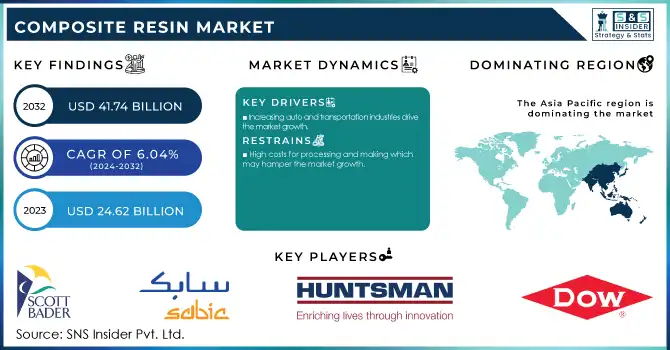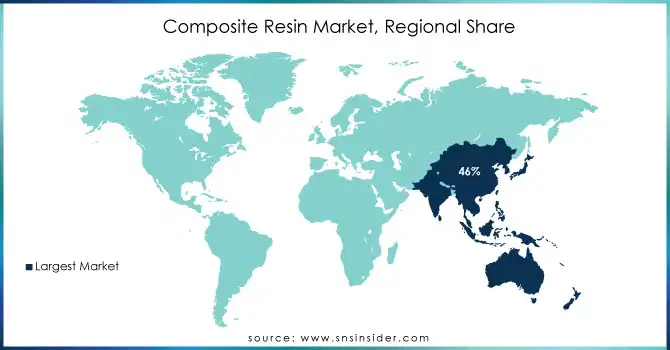Composite Resin Market Report Scope & Overview:
The Composite Resin Market Size was USD 24.62 billion in 2023 and is expected to reach USD 41.74 billion by 2032 and grow at a CAGR of 6.04% over the forecast period of 2024-2032.

Get More Information on Composite Resin Market - Request Sample Report
The increased usage of composite resins for construction and infrastructure owing to their superior properties over traditional materials such as steel and concrete is propelling the growth of the composite resins market. Innovative, durable, and economic construction materials are increasingly in demand due to global attention on sustainable infrastructure development. Moreover, the use of composite resins in retrofitting old structures is increasing too, as these materials contribute to the longer service life of structures, such as buildings & bridges. The ability of these rocks to resist severe environmental conditions establishes their function in contemporary buildings not only in beneficial safety but also as environmentally sound construction.
In the U.S., the National Association of Corrosion Engineers (NACE) estimated that corrosion costs infrastructure sectors over USD 276 billion annually. Composite resins, with their corrosion-resistant properties, are being increasingly used to mitigate these costs.
The growing demand for composite resins is heavily driven by the expansion of the renewable energy sector, as these materials are recognized as low-weight, long-lasting and possessing high tensile strength. Wind turbines, which demand materials capable of sustaining harsh environmental conditions with structural performance, rely heavily on composite resins in their blades. As the world works toward cleaner energy sources, wind farm installation is on the rise. As an example, the Global Wind Energy Council announced a 9% increase in worldwide wind energy capacity in 2023 with major players including China, the U.S., and India. Moreover, the composite resin for solar energy, such as panel frames and support frames using these materials helps to improve performance and durability.
Substantial composite resin market opportunities are being vigored by government initiatives including the "Fit for 55" package from the European Union, which calls for a 40% share of local renewable energy by 2030 as well as India's commitment to add 20 GW of wind energy capacity by 2025. All these developments highlight the importance of the material and the role it plays in the growth of the renewable energy sector.
Composite Resin Market Dynamics
Drivers
-
Increasing auto and transportation industries drive the market growth.
The rise of the composite resin market is directly related to its application in automotive and transportation industries where manufacturers from the automotive industry are demanding lightweight and endurable materials to accelerate efficiency and performance. Due to their excellent strength-to-weight ratio and corrosion resistance, composite resins (especially epoxy and polyester) are widely used in various vehicle components, including body panels, interiors, and structural parts. The increase in demand for composite resins has been further exaggerated due to the upswing in electric (EV) vehicles. Global EV sales totaled more than 10 million units in 2023, an increase of 35% over the previous year, the International Energy Agency (IEA) recently announced.
The successive growth of composite resins is also driven by the aerospace sector, which is strongly oriented toward advanced materials for lightweight aircraft. Composite materials have been incorporated into the latest models of Boeing and Airbus which they have linked to a greater need for fuel-efficient designs. The growing uptake due to automotive, transportation, and also aerospace sectors reiterates the significance of composite resins in the evolution of mobility solutions.
Restraint
-
High costs for processing and making which may hamper the market growth.
The rising costs for composite resin processing and manufacturing would be the main obstacle in growth of the market. The manufacture of composite resin requires sophisticated technology, high-tech equipment, and experienced labor, resulting in a high production cost. Furthermore, the basic materials utilized like epoxy, polyester, and carbon fibers are very expensive, which also raises the total production costs. Such costs can be prohibitively high, discouraging small and medium-sized manufacturers from utilizing composite resins in cost-sensitive markets. In addition, for industries such as automotive and construction, cost efficiency is deemed more significant than composite resins even providing better performance compared to traditional materials, for example, steel or aluminum, which restricts the automotive and construction industries from using composite materials.
Composite Resin Market Segmentation Analysis
By Resin Type
Thermoplastic Composite Resin held the largest market share around 68% in 2023 because they combine high performance with ease of processing and recycling. Thermoplastic composite materials are of special interest to automotive, aerospace, and construction industries that demand high-performance materials at competitive prices, due to this ability of recyclability which results in the reduction of waste and lower production costs. In addition, thermoplastic composite resins display excellent mechanical properties such as high strength, impact resistance, and thermal stability and are suitable for high-demanding applications such as lightweight automotive parts and durable aerospace components.
By Application
The construction & infrastructure sector held the largest market around 24% in 2023. This is owing to the increasing demand for durable, lightweight, and corrosion-resistant materials in modern construction projects. Due to their excellent durability and longer life span under severe environmental loading conditions compared to traditional materials like steel and concrete, composite resins are gaining diverse fields of application as structural reinforcement, panels, and roofing material. The rapid urbanization and escalation in infrastructural development, especially in regions such as Asia-Pacific and North America assists in inducing composite resin utilization in this sector. The demand for these advanced materials has triggered government investments in similar infrastructure projects.
Composite Resin Market Regional Outlook
Asia Pacific held the highest market share around 46% in 2023. Due to the rapid industrialization and strong manufacturing capabilities. Within the Asia-Pacific, China, India, and Japan are undergoing rapid urbanization and infrastructure development, increasing the consumption of composite resins, which are utilized in creating durable and sustainable materials. Moreover, Asia-Pacific has seen several automotive manufacturing plants, wherein composite resins are required for lightweight and fuel-efficient vehicles following the increasing demand for electric vehicles (EVs). Being the largest market for wind energy, the region has been investing heavily in renewable energy infrastructure both in countries like China and India, coupled with wind turbine applications, which will show significant growth in the composite resins market, and the demand for wind turbine applications among others. Asia-Pacific also continues to lead with its significant presence in aerospace and defense industries and its growing importance in electrical and electronics industries. These trends garner support from government initiatives including China's Made in China 2025 strategy and India's emphasis on the growth of renewable energy, which have made the Asia-Pacific the largest consumer of composite resins.

Get Customized Report as per Your Business Requirement - Request For Customized Report
Key Players in Composite Resin Market
-
Schott Bader Company Limited (Epoxy Resins, Vinyl Ester Resins)
-
SABIC (Polycarbonate Resins, Epoxy Resins)
-
Huntsman International LLC (Araldite Epoxy Resins, Huntsman Vinyl Ester Resins)
-
The Dow Chemical Company (DER Epoxy Resins, D.E.R. 331)
-
Hexion Inc (Epoxy Resins, Phenolic Resins)
-
Polynt S.p.A. (Unsaturated Polyester Resins, Vinyl Ester Resins)
-
Kukdo Chemical Co., Ltd. (Epoxy Resins, Hardener for Epoxy Resins)
-
Sumitomo Bakelite Co., Ltd. (Phenolic Resins, Epoxy Resins)
-
Royal DSM N.V (DSM Composite Resins, Akulon Resins)
-
BASF SE (Molded Resins, Glass Fiber Reinforced Resins)
-
Arkema SA (Acrylates Resins, Epoxy Resins)
-
Ashland Global Holdings Inc. (Acrylic Resins, Vinyl Ester Resins)
-
3M (Scotchcast Resin, 3M Epoxy Resins)
-
Lanxess AG (Durethan Resins, Tepex Composite Materials)
-
Momentive Performance Materials Inc. (Epoxy Resins, Silane Coupling Agents)
-
Mitsubishi Chemical Corporation (Epoxy Resins, Polycarbonate Resins)
-
Toray Industries Inc. (Carbon Fiber Reinforced Resin, Epoxy Resin)
-
Sika AG (Sikadur Resins, Epoxy Grouts)
-
Ineos Styrolution (Styrene-based Resins, Acrylonitrile Butadiene Styrene (ABS) Resins)
-
Cytec Solvay Group (Aerospace Resins, Epoxy Resin Systems)
Recent Development:
-
In 2023, Schott Bader introduced a new range of high-performance epoxy resins specifically designed for wind turbine blade manufacturing. This development focuses on enhancing the durability and environmental resistance of composite materials used in the renewable energy sector.
-
In 2023, SABIC launched a new line of high-performance composite resins for use in automotive lightweighting applications. These resins are designed to reduce vehicle weight while improving fuel efficiency, supporting the automotive industry’s transition to electric vehicles.
| Report Attributes | Details |
|---|---|
| Market Size in 2023 | USD 24.62 Billion |
| Market Size by 2032 | USD 41.74 Billion |
| CAGR | CAGR of 6.04% From 2024 to 2032 |
| Base Year | 2023 |
| Forecast Period | 2024-2032 |
| Historical Data | 2020-2022 |
| Report Scope & Coverage | Market Size, Segments Analysis, Competitive Landscape, Regional Analysis, DROC & SWOT Analysis, Forecast Outlook |
| Key Segments | •By Resin Type (Thermoset Composite Resin, Thermoplastic Composite Resin) •By Manufacturing Process (Layup, Filament Winding, Injection Molding, Pultrusion, Compression Molding, Resin Transfer Molding, Others) •By Application (Construction & Infrastructure, Transportation, Electrical & Electronics, Pipes & Tanks, Wind Energy, Marine, Aerospace & Defense, Others) |
| Regional Analysis/Coverage | North America (US, Canada, Mexico), Europe (Eastern Europe [Poland, Romania, Hungary, Turkey, Rest of Eastern Europe] Western Europe] Germany, France, UK, Italy, Spain, Netherlands, Switzerland, Austria, Rest of Western Europe]), Asia Pacific (China, India, Japan, South Korea, Vietnam, Singapore, Australia, Rest of Asia Pacific), Middle East & Africa (Middle East [UAE, Egypt, Saudi Arabia, Qatar, Rest of Middle East], Africa [Nigeria, South Africa, Rest of Africa], Latin America (Brazil, Argentina, Colombia, Rest of Latin America) |
| Company Profiles | Schott Bader Company Limited, SABIC, Huntsman International LLC, The Dow Chemical Company, Hexion Inc, Polynt S.p.A , Kukdo Chemical Co., Ltd., Sumitomo Bakelite Co, Ltd, Royal DSM N.V, BASF SE, Arkema SA, Ashland Global Holdings Inc, and other players. |

